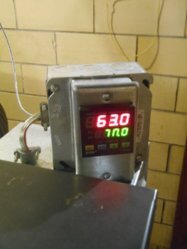These trends represent a gain scheduling approach to o2 control, the pid first set's range is from 20.9% o2 to 7% o2, with proportional band =25, integral =4min,30sec, derivative=2.5sec. The early starting controller output allows a gentle descent to the 7% switch point. From there the second pid set takes over proportional band=28, integral=22.5sec and derivative at 1sec, the operating setpoint is 5%o2 [the flat orange line at 5%]. The second pid set is relatively aggressive at holding the process value [blue line] close to the sp, with pretty dependable disturbance control.
This is a pretty simple strategy that seems to work well for o2 control, one single input, o2/ one output to dampers. I have not tried gain scheduling using temp instead of o2 but it should have some degree of success.
Last edited:



